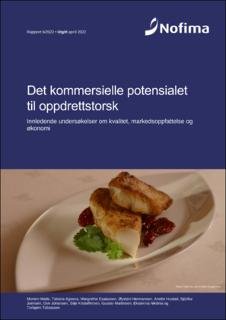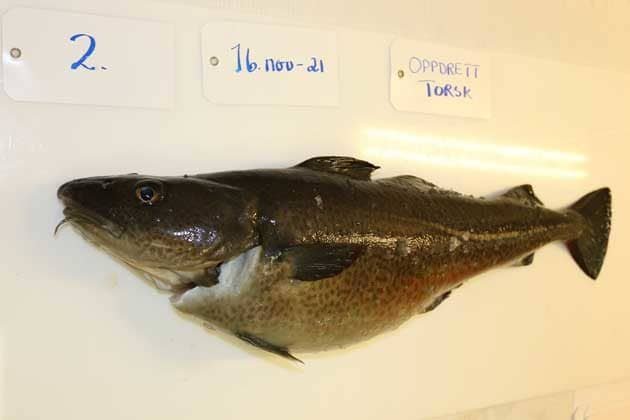By Heidi Kornholt*
Denmark.- In order to achieve the UN’s Sustainable Development Goals, we should utilize the ocean’s resources and create nutritional foods from the seafood industry’s side-streams, e.g. cod livers or off-cuts from fish fillets. The National Food Institute is looking beneath the ocean surface and is creating the foundation of the foods of the future.
The seafood industry’s side streams contain a great potential as a source for developing nutritional and sustainable foods or feed for animals. The side streams are those parts of the catch or the fish that are not utilized today, but are simply thrown overboard and end up as waste or are used in low-value products such as
mink feed. The National Food Institute works closely with the fishing industry on finding solutions as to how the sustainable and nutritional foods of the future can be produced on a large scale and reach the consumers.
“Cod livers can provide healthy omega-3 fatty acids, and shrimp shells contain both taste and colour which the industry can use to produce new types of foods,” Professor and Head of Research Group Charlotte Jacobsen says. She stresses that until now only far too little research has been conducted on how the resources
of the sea can contribute to new, healthy, and sustainable foods.
The researchers at the National Food Institute collaborate with the seafood industry on changing the logistics in the production so that e.g. cod livers are not discarded but instead used for food. The Institute is also exploring ways of utilizing skin from fish and extracting bioactive substances from carcasses, and how process water (waste water) from other types of production can contribute to a more sustainable feed source in the production of algae.
2In the old times, dairies considered whey to be a residual and waste product, but today, it is one of the most valuable products in the production. Now is the time to explore how we can utilize the side streams of the seafood industry to produce new, more sustainable products, which are rich in beneficial bioactive substances such as fish oil and protein,” Charlotte Jacobsen says.
Valuable fish oil from fish waste
Filleting of fish results in tonnes of residual products which are full of healthy omega-3 fish oils. Instead of discarding the residual products, it would be more sustainable and add extra value for the seafood industry to extract the oils and use them as ingredients in health-promoting foods.
“Along with companies in the seafood industry, the National Food Institute conducts research in the design of omega-3 ingredients and the use of them in foods. Such ingredients will make it possible for food producers to enrich existing foods or develop new foods with a favourable health profile,” Charlotte Jacobsen says.
Stay Always Informed
Join our communities to instantly receive the most important news, reports, and analysis from the aquaculture industry.
The sea offers healthy fats
In general, the National Food Institute works on how omega-3 fatty acids can become a more attractive alternative to less healthy fats in our food that also have a greater climate impact, such as animal fat.
“It is paradoxical how little omega-3 is actually in a shrimp salad so why not replace the unhealthy fat with the nutrient-rich oil?” Charlotte Jacobsen asks.
Other suggestions for foods where omega-3 could play a greater role are mayonnaise, dressings, tuna salad, fish pâtés, and protein bars – just to mention a few.
Starfish become animal feed
The ocean and the seafood industry have a large and unfulfilled potential, not only when it comes to candidates for sustainable and nutrient-rich foods and food ingredients for people, but also as feed for animals.
The world’s first starfish meal factory has opened its doors by the Limfjord where the plague of the seabed, starfish, is being turned into animal feed. For a long time, the large stocks of starfish – up to 50 per square metre – have been a problem for mussel fishermen in the Limfjord, because the starfish eat large quantities of mussels and oysters.
“Starfish meal contains 70 % protein, and in 2017 the product was, on Denmark’s request, approved in the EU as feed for domestic animals, including chickens and pigs,” Charlotte Jacobsen says.
Starfish also contain fats. The National Food Institute is exploring the composition of the starfish oil, and how it can be extracted from starfish with a view to a potential production of starfish oil rich in omega-3.
Algae and mussels can also become feed
The small organisms of the sea, the microalgae, are also of interest when it comes to creating sustainable feed for domestic animals.
Therefore, the researchers at the National Food Institute are exploring ways of growing microalgae, which can replace fishmeal and fish oil in fish feed. In the hunt for a sustainable future, the researchers have also developed a way to process mussels that are too small to be sold as foods into a financially viable, sustainable and organic ingredient in chicken and pig feed.
After experimenting with meat grinders, juicers, and various equipment from the Institute’s test facility, the researchers have found a promising and sustainable method to process small mussels. The method leaves out the expensive cooking process and the time-consuming sorting process in which other species such as starfish and crustaceans are removed. Instead, the new method involves putting the mussels, including shells and any nutrient-rich by-catch, through a meat grinder and then
through a press that separates the mass into a fluid and a dry matter. The fluid is then dried into meal, which can be mixed with the feed.
Contact
Charlotte Jacobsen
Professor, Head of Research Group
National Food Institute
+45 23 27 90 75
chja@food.dtu.dk
*Source: The National Food Institute – DTU
Editor at the digital magazine AquaHoy. He holds a degree in Aquaculture Biology from the National University of Santa (UNS) and a Master’s degree in Science and Innovation Management from the Polytechnic University of Valencia, with postgraduate diplomas in Business Innovation and Innovation Management. He possesses extensive experience in the aquaculture and fisheries sector, having led the Fisheries Innovation Unit of the National Program for Innovation in Fisheries and Aquaculture (PNIPA). He has served as a senior consultant in technology watch, an innovation project formulator and advisor, and a lecturer at UNS. He is a member of the Peruvian College of Biologists and was recognized by the World Aquaculture Society (WAS) in 2016 for his contribution to aquaculture.




